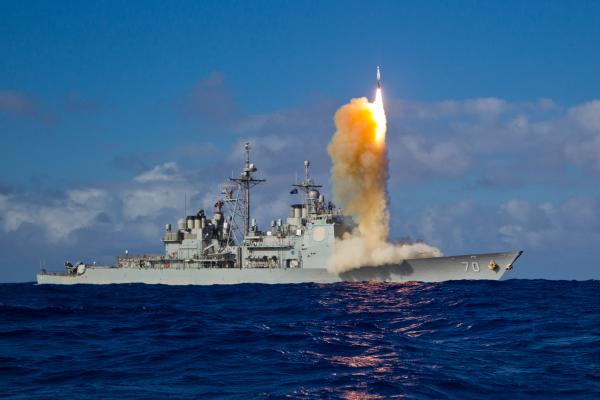Missile Defense: SM-3 Interceptor Makes A High-Altitude Hat Trick
Posted on

Navy cruiser Lake Erie launches a SM-3 IB missile in yesterday’s test.
After failing its first test back in 2011, the Raytheon-built SM-3 Block IB missile looks like it’s back on track, with yesterday marking the third successful test in a row, each against increasingly difficult targets launched from the Pacific Missile Range Facility on Kauai island in Hawaii. The SM-3 IB is the latest iteration of the venerable Standard Missile, the main weapon fired by the fleet’s Lockheed Martin-built Aegis defense system, which makes it central to the Navy’s role in missile defense.
“It has worked three successive times in very stressing conditions and it has performed flawlessly,” declared Raytheon’s program director, Mitch Stevison, in a conference call with journalists today. Of the three, he added, “this was by far the most challenging for the missile seeker itself.”
The first successful test, in May 2012, hit what’s called a “unitary target,” that is a simulated enemy missile whose warhead and rocket booster stayed together throughout their flight. For the second test, in June, the warhead and booster separated, presenting a more complex challenge for the Aegis tracking and targeting radars. Then came a long gap. Now, after 11 months, the third test involved a target that not only separated but had unspecified features to challenge the infra-red seeker on the SM-3 itself.
The next test is expected between October and December of this year, and it will up the difficulty again: either multiple SM-3s will launch at once or there will be multiple incoming targets.
So far, the ship launching the Standard Missiles for the tests, the Aegis cruiser Lake Erie, has tracked and engaged the targets with its own onboard radars. However, a second warship was apparently watching this test with its sensors as well, although Stevision was very cagey on details. In the long run, the goal is for satellites, aircraft and other ships to relay targeting data via wireless networks to the launch platform, long before its own radar can see anything, a concept called “launch on remote.”
Ultimately, though, shooting down enemy missiles with your own anti-missile missiles is an expensive game. Defensive missiles generally cost orders of magnitude more than offensive ones – the attacker just has to hit a ship or ground target, the defender has to hit a supersonic missile – and you can only carry so many.
So the Navy’s long-term hope for missile defense is lasers, which can in theory fire an infinite number of shots for no more that the price of electricity to power it. By early next year, the fleet will in fact send a prototype laser to the Persian Gulf. That system will only have the power and accuracy to take on slow, low-altitude targets like small drones, but the Navy hopes it’s a forerunner of what’s to come.
Subscribe to our newsletter
Promotions, new products and sales. Directly to your inbox.
